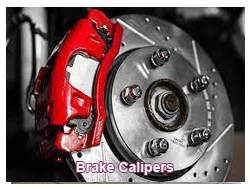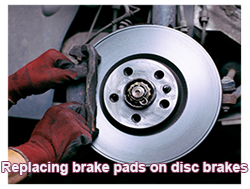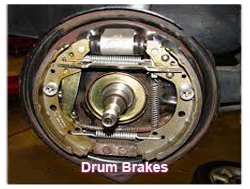
CABLE ACTIVATED:Describes a device controlled by a cable - the longer the cable, the less efficient the system is.
CABLE BRAKE: Describes a braking device activated by cable.
Describes a braking device activated by cable.
CADENCE BRAKING: Describes a braking method in which the driver rapidly depresses and releases the brake pedal to bring a vehicle to an emergency stop.
CALIPER: Describes the apparatus on disc brakes that hold the disc pads and straddles the disc. When actuated, the pads press against the disc to stop or slow the vehicle.
CAST SPOKE ASSEMBLY: Describes the part of the vehicle consisting of the brake drum and wheel spider, having 3, 5 or 6 spokes.
CERAMIC BRAKE PAD: Describes a brake pad constructed with ceramics to reduce wear and heat.
COMPENSATING PORT: Describes the small hole in a brake master cylinder that permits fluid to return to the reservoir.
COMPENSATOR: Describes the horizontal bar pulled forward when the parking brake is applied at its central point, enabling equal force to be exerted on each rear brake.
COMBINATION VALVE: Describes the pressure-regulating valve in braking systems incorporating a failure warning switch and comprising two or more of the following valves: pressure-differential valve, metering valve, and proportioning valve.
DIAGONALLY SPLIT SYSTEM: Describes a dual-circuit braking system in which each circuit brakes one front wheel and the diagonally opposite rear wheel so that in the case of failure of one circuit, reasonably balanced braking can be achieved.
DISCARD THICKNESS: Describes the maximum thickness at which a brake disc has become unsafe and should be replaced,
DISC BRAKE: Describes a type of brake comprising two primary components: a flat rotor (disc) that turns with the wheel and a calliper that is in a permanent stationary position. When the brake pedal is depressed, linkage (which can be either mechanical or hydraulic) causes the calliper to force its heat-resistant brake pads against both sides of the rotating disc stopping the wheel from rotating. Most new cars come fitted with disc brakes on the front and drum brakes on the rear.
DOUBLE LEADING BRAKE SHOE: Describes a braking system in which two hydraulic plungers and separate pivots are combined to create better braking when the vehicle is going forward.
DRUM BRAKE: Describes a type of brake using a shallow drum-shaped metal cylinder that attaches to the inner surface of the wheel and rotates with it. When the driver presses down on the brake pedal, curved brake shoes with friction linings compress against the inner circumference of the drum to slow the vehicle.
DUAL BRAKES: Describes a brake system that utilises a tandem or dual master cylinder to provide a separate brake system for both the front and rear of the vehicle. In the event of a loss of hydraulic fluid, one system may still work because it is independent of the other system. Often the front left brake is linked with the right rear brake. Also known as a "dual-circuit braking system."
DUAL REDUCTION AXLE: Describes a form of drive axle construction with two sets of pinions and gears, either of which can be used
DUO-SERVO BRAKE: Describes a type of servo brake fitted with one double-end wheel cylinder and two linked self-energising brake shoes.
DUO-SERVO BRAKE: Describes a type of servo brake fitted with one double-end wheel cylinder and two linked self-energising brake shoes.
DUST CAP: Describes a metal or plastic covering that fits into a hub shell to keep contaminants out of hub bearings.
Describes a metal or plastic covering that fits into a hub shell to keep contaminants out of hub bearings.
DUST SHIELD: Describes a sheet metal disc placed on the brake assembly to prevent dust or other foreign bodies from reaching the brake assembly.
CCG


